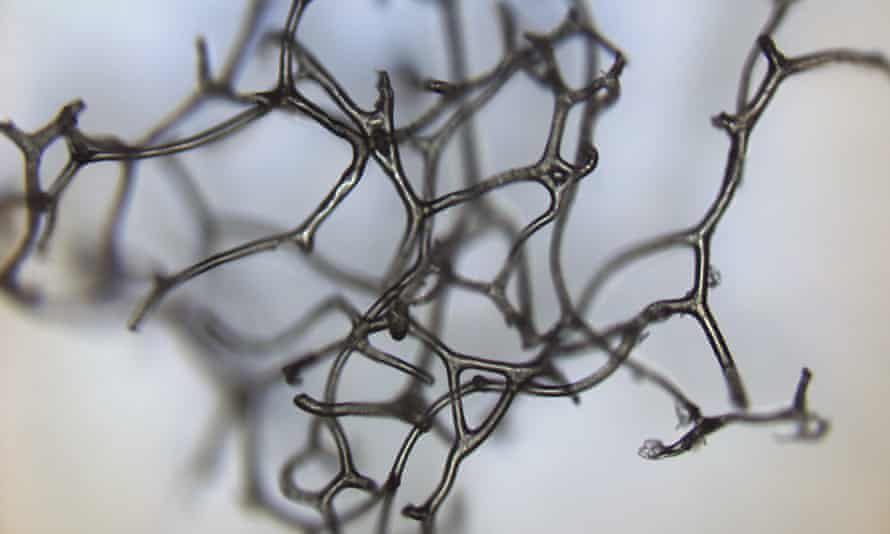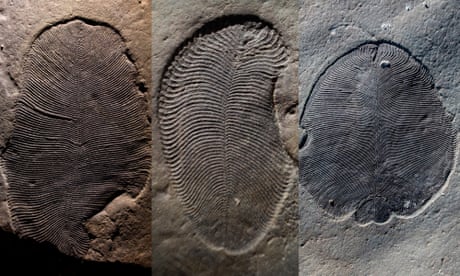Scientists believe the unusual tubular structures may be the remnants of prehistoric sponges

A fragment of the skeleton of a modern keratose sponge (a bath sponge from Greece – Spongia officinalis), highlighting its 3D meshwork. Photograph: EC Turner
Ian Sample Science editor
Ian Sample Science editor
THE GUARDIAN
Wed 28 Jul 2021
Intricate patterns of tubular structures discovered in giant ancient reefs may be the remnants of prehistoric horny sponges and the oldest known fossils of animal life on Earth.
Researchers found the unusual features in vast reefs that were built by bacteria 890m years ago and then pushed up by geological processes to form part of the Mackenzie Mountains in north-western Canada.
Examined under a microscope, a small number of rock samples revealed tubules about half the width of a human hair that branch and reconnect to form 3D structures that are strikingly similar to those seen in fossils of bath sponges.
“Initially, when you look at these features they look like a bunch of wiggles, but when you try to follow each of the strands, you realise that even in thin sections they form complicated 3D meshworks,” said Prof Elizabeth Turner, at Laurentian University in Sudbury, Ontario.

Wed 28 Jul 2021
Intricate patterns of tubular structures discovered in giant ancient reefs may be the remnants of prehistoric horny sponges and the oldest known fossils of animal life on Earth.
Researchers found the unusual features in vast reefs that were built by bacteria 890m years ago and then pushed up by geological processes to form part of the Mackenzie Mountains in north-western Canada.
Examined under a microscope, a small number of rock samples revealed tubules about half the width of a human hair that branch and reconnect to form 3D structures that are strikingly similar to those seen in fossils of bath sponges.
“Initially, when you look at these features they look like a bunch of wiggles, but when you try to follow each of the strands, you realise that even in thin sections they form complicated 3D meshworks,” said Prof Elizabeth Turner, at Laurentian University in Sudbury, Ontario.

Prof Elizabeth Turner on northern Baffin Island, Nunavut.
Photograph: C Gilbert
“Thanks to the wonderful work of others, younger examples of the same microstructures have been found in sponge body fossils and these structures have been compared to the skeletons of a variety of keratose, or horny, sponges,” she added.
While modern reefs are built by corals and algae, in Earth’s distant past communities of photosynthetic cyanobacteria created enormous carbonate reefs measuring many kilometres wide and hundreds of metres thick.
Prof Turner first spotted the weird tubules in a handful of thin sections of rock she gathered as a PhD student during field work at the site. Two decades on, she has built up the collection and discovered more examples of the features in the rocks.
Writing in the journal Nature, Turner describes how the fossils may have formed when putative sponges, measuring a few millimetres to a centimetre across, became mineralised. The soft tissue is first to fossilise, encasing the 3D network of collagen-like fibres that form the sponge’s skeleton. Over time, these skeletal fibres decay, leaving hollow tubules that fill up with calcite crystals.
If the structures are confirmed as early sponge fossils, they would predate the next-oldest undisputed sponge fossils by about 350m years.

558m-year-old fossils identified as oldest known animal
According to previous studies, sponges are some of the earliest animals on Earth and emerged during the early Neoproterozoic era one billion to half a billion years ago. However, the exact timing is uncertain. Other research suggests that oxygen levels were too low for animals to thrive until they rose in the Neoproterozoic Oxygenation Event between 800m and 540m years ago.
But even on an oxygen-starved Earth, early sponges may have found a way to survive in the nooks and crannies of microbial reefs if the photosynthetic bacteria that smothered the reefs released enough oxygen into the water. “These possible sponges, or whatever they were, were living in a reef that was an oxygen factory, it was nirvana,” said Prof Turner. For food, they could have consumed the polysaccharide slime that sloughed off the microbial mats into the surrounding ocean.
“If I’m right about the interpretation of this material, then the earliest animals may not have had the same oxygen requirements that we have assumed so far. It’s possible that we had early sponges emerge some time ago, and certainly by 890m years ago, living in a comparatively low oxygen world, but the more complicated animals had to wait a while,” she added.
Far more work is now needed to see whether other rocks of a similar age contain traces of early animal life. “We have to approach it with a much more open mind,” said Prof Turner. “We have to think about what we should expect from early animals. Anything we think of as animal may be too complicated. We want to look for something that expresses the essence of animals, without being too conspicuously familiar.”
“Thanks to the wonderful work of others, younger examples of the same microstructures have been found in sponge body fossils and these structures have been compared to the skeletons of a variety of keratose, or horny, sponges,” she added.
While modern reefs are built by corals and algae, in Earth’s distant past communities of photosynthetic cyanobacteria created enormous carbonate reefs measuring many kilometres wide and hundreds of metres thick.
Prof Turner first spotted the weird tubules in a handful of thin sections of rock she gathered as a PhD student during field work at the site. Two decades on, she has built up the collection and discovered more examples of the features in the rocks.
Writing in the journal Nature, Turner describes how the fossils may have formed when putative sponges, measuring a few millimetres to a centimetre across, became mineralised. The soft tissue is first to fossilise, encasing the 3D network of collagen-like fibres that form the sponge’s skeleton. Over time, these skeletal fibres decay, leaving hollow tubules that fill up with calcite crystals.
If the structures are confirmed as early sponge fossils, they would predate the next-oldest undisputed sponge fossils by about 350m years.

558m-year-old fossils identified as oldest known animal
According to previous studies, sponges are some of the earliest animals on Earth and emerged during the early Neoproterozoic era one billion to half a billion years ago. However, the exact timing is uncertain. Other research suggests that oxygen levels were too low for animals to thrive until they rose in the Neoproterozoic Oxygenation Event between 800m and 540m years ago.
But even on an oxygen-starved Earth, early sponges may have found a way to survive in the nooks and crannies of microbial reefs if the photosynthetic bacteria that smothered the reefs released enough oxygen into the water. “These possible sponges, or whatever they were, were living in a reef that was an oxygen factory, it was nirvana,” said Prof Turner. For food, they could have consumed the polysaccharide slime that sloughed off the microbial mats into the surrounding ocean.
“If I’m right about the interpretation of this material, then the earliest animals may not have had the same oxygen requirements that we have assumed so far. It’s possible that we had early sponges emerge some time ago, and certainly by 890m years ago, living in a comparatively low oxygen world, but the more complicated animals had to wait a while,” she added.
Far more work is now needed to see whether other rocks of a similar age contain traces of early animal life. “We have to approach it with a much more open mind,” said Prof Turner. “We have to think about what we should expect from early animals. Anything we think of as animal may be too complicated. We want to look for something that expresses the essence of animals, without being too conspicuously familiar.”
Sponge structures may be Earth's oldest animal life
Issued on: 28/07/2021

Genetic evidence from modern sponges suggests they could have been
around for up to 1 billion years IBRAHIM CHALHOUB AFP/File
Paris (AFP)
Fossilised structures discovered in northwestern Canada may be from sponges that lived in oceans as long as 890 million years ago, making them the earliest known animal life on Earth, research showed on Wednesday.
The findings also challenge the long-held idea that animals did not arise on Earth until after a major infusion of oxygen into the atmosphere and oceans.
Sponges are simple animals with an ancient history. Genetic evidence gathered from modern sponges has shown they likely emerged between 1 billion and 500 million years ago.
But until now there has been no evidence of fossilised sponge bodies from this period, known as the early Neoproterozoic era.
Elizabeth Turner, a professor at Canada's Laurentian University's Harquail School of Earth Sciences, looked for evidence of sponges in 890-million-year-old reefs that were constructed by a type of bacteria that deposited calcium carbonate.
She found networks of tiny tube-shaped structures containing crystals of the mineral calcite -- suggesting they were contemporaneous to the reef -- that closely resemble the fibrous skeleton found within some modern sponges.
If her structures Turner identified end up being verified as sponge samples, they will outdate the current oldest known sponge fossils by 350 million years.
Although the implications of her possible discovery, published in the journal Nature, Turner said she was not getting carried away.
"The earliest animals to emerge evolutionarily were probably sponge-like. This too is not surprising, given that sponges are the most basic animal in the tree of animal life," she told AFP.
"The nature of the material is familiar from the bodies of much younger body fossils of sponges," Turner said.
She said the possible sponges were around one centimetre across, and "would have been tiny and inconspicuous, living in shadowy nooks and crannies below the upper surfaces of the reefs"
If the structures do turn out to be confirmed as sponge specimens, that means they would have lived roughly 90 million years before Earth's oxygen levels reached levels thought to be necessary to support animal life.
Turner said that if confirmed to be sponges, she believed that they lived before the Neoproterozoic oxygenation event, during which oxygen levels increased, subsequently leading to the emergence of animal life.
"If I am correct in my interpretation of the material, the earliest animals appeared before that event and may have been tolerant of comparatively low oxygen levels, relative to modern conditions," she said.
"It is possible that the earliest animals were tolerant of low oxygen -- some modern sponges are -- but that more complex animal types that require a higher oxygen level did not appear until after the Neoproterozoic oxygenation event," Turner added.
© 2021 AFP
No comments:
Post a Comment